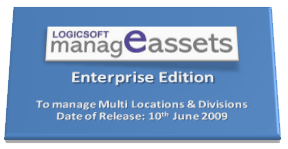Logicsoft
ManageAssets
Managing IT Assets & Complaints Tracking - A Challenge

manageAssets - Enterprise Edition launched.
Based on popular demands and reviews received from the industry user groups over last few months, this new manageAssets – Enterprise Edition has been launched.
Click here to read the related Press Release Bulletin dated 10th June 2009
The diversity of technology asset classes and their total count has grown exponentially over the past few years. As technology-driven innovation continues to penetrate new industries and business functions, this diversity and the count are going to grow even more dramatically.
IT assets will need to be measured for a variety of business, risk, and operational management reasons in the future. The diversity and complexity of these IT Assets, and their critical need within the business, place significant pressure on IT departments to measure them and ensure that business and operational risks are mitigated.
The IT Asset Management (ITAM) function is the primary point of accountability for the life-cycle management of information technology assets throughout the organization. Included in this the responsibility of development and maintenance of policies, standards, processes, systems and measurements that enable the organization to manage the IT Asset Portfolio with respect to risk, cost, control, IT Governance, credibility, compliance and business performance objectives as established by the business.
Complaint management has become an integral part of business, both from a regulatory perspective and a customer service standpoint. Simply stated, complaint management is the formal process of recording and resolving a user complaint. Complaints are expensive, both in direct and indirect costs. But for this price, companies can extract priceless knowledge, because complaints contain the direct voice of the user groups. If complaints are transformed into knowledge about user groups, they can provide a valuable amount of capital for enterprises. To exploit this capital, companies must design, build, operate and continuously upgrade systems for managing complaints. These systems are called “complaint management systems”.

